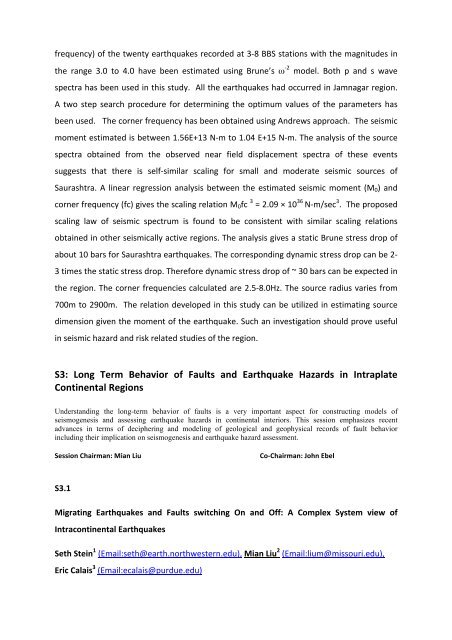indo–us workshop on “intraplate seismicity†- The CERI Blog
indo–us workshop on “intraplate seismicity†- The CERI Blog
indo–us workshop on “intraplate seismicity†- The CERI Blog
Create successful ePaper yourself
Turn your PDF publications into a flip-book with our unique Google optimized e-Paper software.
frequency) of the twenty earthquakes recorded at 3-‐8 BBS stati<strong>on</strong>s with the magnitudes in<br />
the range 3.0 to 4.0 have been estimated using Brune’s ω -‐2 model. Both p and s wave<br />
spectra has been used in this study. All the earthquakes had occurred in Jamnagar regi<strong>on</strong>.<br />
A two step search procedure for determining the optimum values of the parameters has<br />
been used. <strong>The</strong> corner frequency has been obtained using Andrews approach. <strong>The</strong> seismic<br />
moment estimated is between 1.56E+13 N-‐m to 1.04 E+15 N-‐m. <strong>The</strong> analysis of the source<br />
spectra obtained from the observed near field displacement spectra of these events<br />
suggests that there is self-‐similar scaling for small and moderate seismic sources of<br />
Saurashtra. A linear regressi<strong>on</strong> analysis between the estimated seismic moment (M0) and<br />
corner frequency (fc) gives the scaling relati<strong>on</strong> M0fc 3 = 2.09 × 10 36 N-‐m/sec 3 . <strong>The</strong> proposed<br />
scaling law of seismic spectrum is found to be c<strong>on</strong>sistent with similar scaling relati<strong>on</strong>s<br />
obtained in other seismically active regi<strong>on</strong>s. <strong>The</strong> analysis gives a static Brune stress drop of<br />
about 10 bars for Saurashtra earthquakes. <strong>The</strong> corresp<strong>on</strong>ding dynamic stress drop can be 2-‐<br />
3 times the static stress drop. <strong>The</strong>refore dynamic stress drop of ~ 30 bars can be expected in<br />
the regi<strong>on</strong>. <strong>The</strong> corner frequencies calculated are 2.5-‐8.0Hz. <strong>The</strong> source radius varies from<br />
700m to 2900m. <strong>The</strong> relati<strong>on</strong> developed in this study can be utilized in estimating source<br />
dimensi<strong>on</strong> given the moment of the earthquake. Such an investigati<strong>on</strong> should prove useful<br />
in seismic hazard and risk related studies of the regi<strong>on</strong>.<br />
S3: L<strong>on</strong>g Term Behavior of Faults and Earthquake Hazards in Intraplate<br />
C<strong>on</strong>tinental Regi<strong>on</strong>s<br />
Understanding the l<strong>on</strong>g-term behavior of faults is a very important aspect for c<strong>on</strong>structing models of<br />
seismogenesis and assessing earthquake hazards in c<strong>on</strong>tinental interiors. This sessi<strong>on</strong> emphasizes recent<br />
advances in terms of deciphering and modeling of geological and geophysical records of fault behavior<br />
including their implicati<strong>on</strong> <strong>on</strong> seismogenesis and earthquake hazard assessment.<br />
Sessi<strong>on</strong> Chairman: Mian Liu Co-‐Chairman: John Ebel<br />
S3.1<br />
Migrating Earthquakes and Faults switching On and Off: A Complex System view of<br />
Intrac<strong>on</strong>tinental Earthquakes<br />
Seth Stein 1 (Email:seth@earth.northwestern.edu), Mian Liu 2 (Email:lium@missouri.edu),<br />
Eric Calais 3 (Email:ecalais@purdue.edu)


